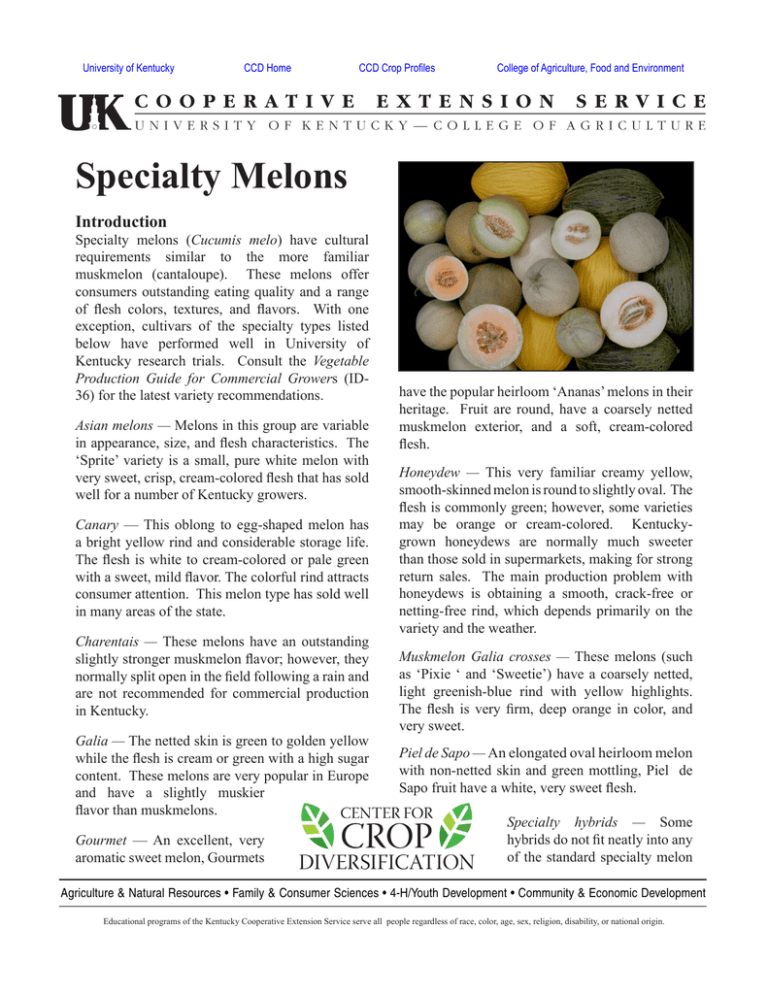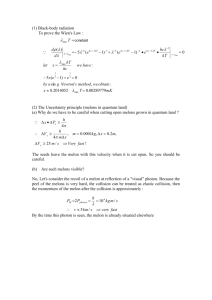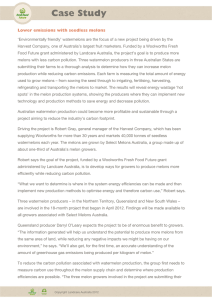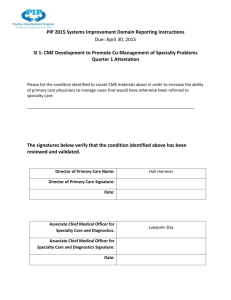Specialty Melons Introduction
advertisement

University of Kentucky CCD Home CCD Crop Profiles College of Agriculture, Food and Environment Specialty Melons Introduction Specialty melons (Cucumis melo) have cultural requirements similar to the more familiar muskmelon (cantaloupe). These melons offer consumers outstanding eating quality and a range of flesh colors, textures, and flavors. With one exception, cultivars of the specialty types listed below have performed well in University of Kentucky research trials. Consult the Vegetable Production Guide for Commercial Growers (ID36) for the latest variety recommendations. Asian melons — Melons in this group are variable in appearance, size, and flesh characteristics. The ‘Sprite’ variety is a small, pure white melon with very sweet, crisp, cream-colored flesh that has sold well for a number of Kentucky growers. Canary — This oblong to egg-shaped melon has a bright yellow rind and considerable storage life. The flesh is white to cream-colored or pale green with a sweet, mild flavor. The colorful rind attracts consumer attention. This melon type has sold well in many areas of the state. Charentais — These melons have an outstanding slightly stronger muskmelon flavor; however, they normally split open in the field following a rain and are not recommended for commercial production in Kentucky. Galia — The netted skin is green to golden yellow while the flesh is cream or green with a high sugar content. These melons are very popular in Europe and have a slightly muskier flavor than muskmelons. Gourmet — An excellent, very aromatic sweet melon, Gourmets have the popular heirloom ‘Ananas’ melons in their heritage. Fruit are round, have a coarsely netted muskmelon exterior, and a soft, cream-colored flesh. Honeydew — This very familiar creamy yellow, smooth-skinned melon is round to slightly oval. The flesh is commonly green; however, some varieties may be orange or cream-colored. Kentuckygrown honeydews are normally much sweeter than those sold in supermarkets, making for strong return sales. The main production problem with honeydews is obtaining a smooth, crack-free or netting-free rind, which depends primarily on the variety and the weather. Muskmelon Galia crosses — These melons (such as ‘Pixie ‘ and ‘Sweetie’) have a coarsely netted, light greenish-blue rind with yellow highlights. The flesh is very firm, deep orange in color, and very sweet. Piel de Sapo — An elongated oval heirloom melon with non-netted skin and green mottling, Piel de Sapo fruit have a white, very sweet flesh. Specialty hybrids — Some hybrids do not fit neatly into any of the standard specialty melon Agriculture & Natural Resources • Family & Consumer Sciences • 4-H/Youth Development • Community & Economic Development Educational programs of the Kentucky Cooperative Extension Service serve all people regardless of race, color, age, sex, religion, disability, or national origin. groups so they have been placed into this general category. A number of cultivars in this group (such as ‘Napoli,’ ‘Sunrise,’ and Tasty Bites’)are outstanding and have consistently performed well in University research trials. Marketing Kentucky fresh market specialty melons are currently being grown on a very limited basis and sold at a few farmers markets in the state. There is some demand for specialty melons through southern Ohio marketing channels, and Kentucky producers may be able to tap into this market. Local upscale restaurants and specialty groceries, as well as community supported agriculture (CSA) subscriptions, are also good possibilities for marketing high quality specialty melons. Produce auctions are an outlet where producers may also be able to move smaller quantities of melons at wholesale prices. Market Outlook Per capita melon consumption increased from 26.4 pounds in 2007 to 27.1 pounds in 2010, the third consecutive annual gain in consumption. Kentucky wholesale melon producers have benefited from strong prices in some past seasons, but face competition from domestic and foreign melon producers with economic and environmental advantages in melon production. However, direct and local melon markets have benefited from increased demand and consumer desire for more diverse produce offerings. Good marketing and sound production are likely to continue to make locally grown retail melons a profitable niche crop. For growers marketing specialty melons directly to the consumer, such as through farmers markets, it will be important to have the customer taste and experience the outstanding flavors of these new melons. Melon sampling at the point of purchase is one way to introduce the health-conscious consumer to the delicious spectrum of specialty melon varieties. Direct marketers must comply with all pertinent state and local regulations, such as attending Good Agricultural Practices (GAP) training, before offering produce samples. Production Considerations Site selection and planting Specialty melons can be grown on medium-textured soils, but do best when grown on sandy or sandy loam soils that are well-drained. Melons should not follow melons, other cucurbits, or solanaceous crops (e.g. tomatoes, peppers, eggplant, and tobacco) in the rotation for at least 3 years because of potential disease problems. Since many specialty melon seeds are expensive, transplanting, rather than direct-seeding, is recommended. Transplants can be produced either in a greenhouse or hotbed. There is little competition for specialty melons in the market, so slightly later planting allows them to ripen in late July and throughout August when there is less rain. This increases melon flavor and sugar content. In addition, black plastic mulch with drip irrigation is highly recommended for specialty melons. Plasticulture encourages faster growth and earlier maturity. It also results in higher yields. Transplants are normally set through plastic with a water wheel setter in Kentucky. Training plants to grow in the rows during the early stages of development will enable an easier harvest. Growers with large acreages should provide one to two strong hives of bees for each acre of plants to ensure good pollination. Pest management Bacterial wilt is the most serious disease threat to specialty melon production in the state, and many specialty cultivars are highly susceptible. To control this disease, it is essential to control the cucumber beetles that carry the pathogen. It is crucial that plants be protected from cucumber beetle feeding beginning the day of seedling emergence or the day of transplanting. A systemic, soil-applied insecticide should be used, followed a month later by a routine insecticide spray program. Other diseases of concern are anthracnose, Fusarium wilt, downy mildew, and powdery mildew. Localized aphid infestations occasionally become a problem and will require control. A top notch insecticide and fungicide spray program is critical to successful specialty melon production. If plants lose their leaves, melons do not sweeten up and flavor is poor. Harvest and storage Unlike muskmelon, most specialty melons do not “slip” from the stem at maturity. Instead, they are hand-cut from the vines at market maturity. Indicators of maturity vary depending on the cultivar and generally include such characteristics as skin color and texture. Harvesting every other day will be necessary during periods of high temperatures. Melons benefit greatly when field heat is removed by forced-air cooling as soon after harvest as possible. Labor requirements Labor needs per acre are approximately 15 hours for production when using transplants, 100 hours for harvest, and 30 hours for grading. Production with black plastic will require an additional 10 hours per acre for post-harvest plastic removal. Economic Considerations Initial investments include land preparation and purchase of seed or transplants. Additional startup costs can include the installation of an irrigation system and black plastic mulch. Production costs for specialty melons are similar to muskmelon, with potential for a greater seed expense for new or rare varieties. Total preharvest variable costs for trickle irrigated specialty melons are estimated at $1,443 per ½ acre, with an additional harvesting and marketing cost of $1,647 per ½ acre. Harvest and marketing expenses can be highly variable in melon production; these estimates assumed a marketing charge (transportation, market labor, etc.) after harvest of 10 percent of gross returns. Total expenses, including fixed costs, were estimated at approximately $3,485 per ½ acre in 2012. Since returns vary depending on actual yields and market prices, the following per ½ acre returns to land and management are based on three different economic scenarios. Conservative estimates represent the University of Kentucky’s 2012 cost and return estimates for specialty muskmelons. Pessimistic $(485) * Conservative $940 Optimistic $3,797 *Parentheses indicate a negative number, i.e. a net loss. Selected Resources • Fruit and Vegetable Crops Research Reports (University of Kentucky) http://www.uky.edu/Ag/Horticulture/comfruit.html • IPM Scouting Guide for Common Problems of Cucurbit Crops in Kentucky (University of Kentucky, 2009) 1.8 MB file http://www.ca.uky.edu/agc/pubs/id/id91/id91.pdf • Vegetable and Melon Budgets (University of Kentucky, 2013) http://www.uky.edu/Ag/cdbrec/vegbudgets13.html • Vegetable Production Guide for Commercial Growers, ID-36 (University of Kentucky) http://www.ca.uky.edu/agc/pubs/id/id36/id36.htm • Cantaloupe and Specialty Melons (University of Georgia, 2009) http://www.caes.uga.edu/Publications/ displayHTML.cfm?pk_id=6278 • Producing Cantaloupes in Tennessee, B-962 (University of Tennessee, 1999) https://utextension.tennessee.edu/publications/ Documents/PB962.pdf Reviewed by John Strang, Extension Specialist (Issued 2004, Revised 2008, Revised 2012) April 2012 Photo courtesy of John Strang, University of Kentucky For additional information, contact your local County Extension agent





